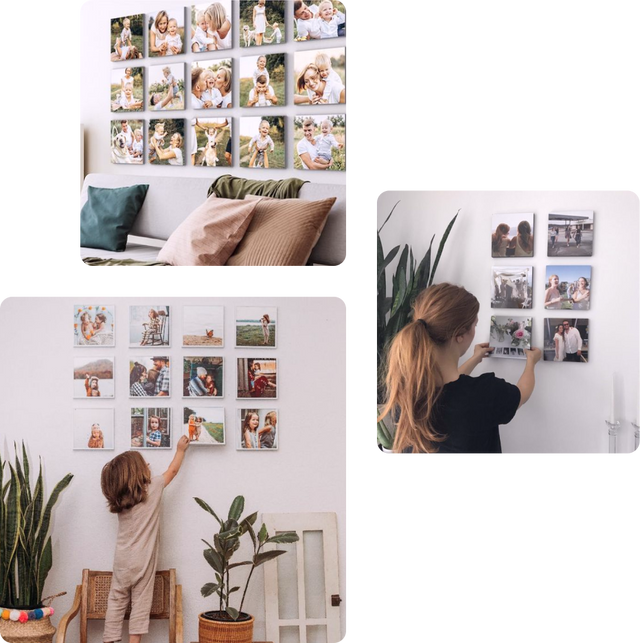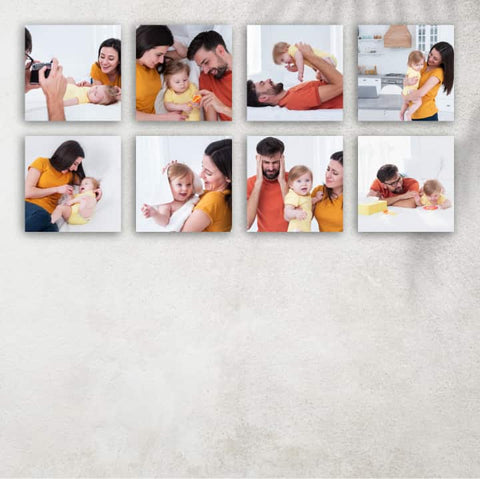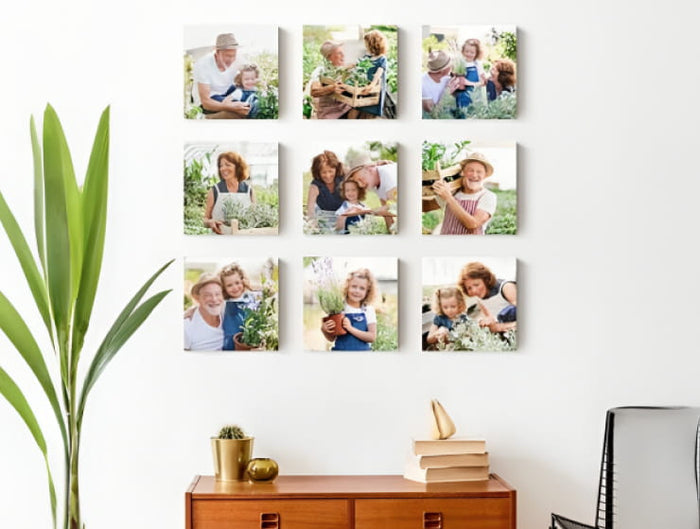The Ultimate Guide to Styling and Creating Canvas Prints
Canvas prints have become a staple in interior design and personal art collections, offering a unique way to showcase photography, artwork, and cherished memories. With their textured surface and artistic appeal, canvas prints bring depth and character to any space. This guide explores everything from styling tips for your home to step-by-step instructions for creating high-quality canvas prints, including at-home projects and print-on-demand services.
Why Canvas Prints Are a Timeless Choice
Canvas prints have a unique and enduring appeal that distinguishes them from traditional framed photographs or standard paper prints. Unlike smooth paper surfaces, canvas adds texture and depth to an image, creating a subtle three-dimensional effect that draws the viewer in. The woven surface of the canvas interacts with light in ways that enhance color saturation and contrast, giving images a sense of vibrancy and life. This tactile quality, coupled with the visual richness, makes canvas prints feel more like fine art than mere photographs. The material itself—commonly cotton, linen, or polyester—also contributes to the overall aesthetic. Cotton canvases offer a natural, textured finish reminiscent of classical paintings, while polyester canvases allow for more vibrant colors, making them ideal for photographic reproductions or digital art.
Beyond aesthetics, the versatility of canvas prints is one of their greatest strengths. They can be incorporated seamlessly into a variety of interior styles, from modern minimalist spaces to traditional or eclectic rooms. In contemporary décor, a large canvas print can serve as a focal point on a blank wall, providing color, structure, and personality. In contrast, smaller canvas prints can be arranged in gallery walls, grouped with framed photos or other decorative elements to create layered, curated visual displays. Canvas prints also make excellent gifts, offering a personal and meaningful way to share photographs, artwork, or special memories. Professional artists frequently use canvas for exhibitions and commissions because the medium elevates their work, giving it an elegant, high-quality presentation without the need for elaborate framing.
Longevity is another key reason canvas prints remain a popular choice. High-quality canvas prints are remarkably durable and resistant to fading, warping, or damage. When printed with archival inks and properly stretched or framed, canvas prints can last for decades without losing their visual appeal. Historical examples highlight this durability: many artworks created on canvas over 600 years ago remain intact and vibrant, preserving the detail and emotion intended by the original artists. This enduring quality makes canvas an ideal medium not only for showcasing art but also for preserving cherished memories in a form that withstands the test of time.
The printing process itself adds to the timelessness of canvas. Unlike paper prints, which can tear or yellow over time, canvas prints are often coated with protective finishes that resist moisture, dirt, and UV damage. This ensures that even in high-traffic areas or sunlit rooms, the print maintains its color fidelity and sharpness. Additionally, modern printing techniques—such as giclée printing—allow for exceptional color accuracy and resolution, capturing every nuance of the original image, from subtle shadows to vibrant highlights.
Ultimately, the combination of tactile texture, visual depth, adaptability, and durability is what gives canvas prints their timeless quality. They are not just decorative pieces; they are enduring statements of style, artistry, and memory preservation. Whether displayed in a living room, bedroom, office, or gallery, canvas prints continue to captivate viewers, blending functionality with elegance in a way that few other mediums can match.
Canvas Prints in Home Décor
Canvas prints are an exceptionally versatile medium for home décor, capable of transforming any space by adding color, texture, and personality. Unlike standard framed photographs, the textured surface of a canvas creates a three-dimensional quality that draws the eye and adds depth to a room. The tactile nature of the canvas, whether cotton or polyester, interacts beautifully with light, creating subtle variations in tone and shadow that make the artwork feel more dynamic and alive. This characteristic makes canvas prints an ideal choice for living areas, bedrooms, offices, or any space where visual impact is desired.
One of the most appealing aspects of canvas prints in home décor is their flexibility in display. They can be hung traditionally on walls, leaned against shelves or mantels, or even propped on easels for a more casual, artistic vibe. This versatility allows homeowners to experiment with arrangements and locations that suit their style and the room’s layout. For instance, a large statement canvas placed above a sofa can serve as the focal point of a living room, tying together colors and textures within the space. Smaller canvases, on the other hand, can be grouped together on gallery walls to create a curated display that tells a story or highlights a particular theme, such as family memories, travel experiences, or artistic collections.
Gallery walls, in particular, are an excellent way to showcase canvas prints. The depth and texture of the canvas add dimension to the wall, creating a dynamic interplay between different art forms. Mixing canvas prints with framed photographs, metal prints, or even wall-mounted sculptures can enhance the visual contrast and make the overall display feel more layered and intentional. When arranging a gallery wall, it is helpful to consider the balance of colors, shapes, and sizes, as well as the spacing between each piece. Canvas prints with subtle textures or neutral tones can serve as anchors for more colorful or intricate works, creating a harmonious and visually pleasing composition.
The choice between framed and unframed canvas prints also plays a significant role in shaping the mood and style of a room. Framed canvases often exude a more formal, polished aesthetic, making them well-suited for spaces such as dining rooms, home offices, or master bedrooms. The frame adds structure and refinement, giving the artwork a finished look that complements classic or traditional décor. Floating frames, where the canvas appears to “hover” within the frame, are particularly popular, offering a contemporary twist on a classic presentation. Traditional wood or metal frames provide warmth or sophistication, depending on the material and finish, and can coordinate with other furniture and décor elements in the room.
Unframed canvas prints, in contrast, provide a relaxed, casual appearance that fits effortlessly into cottages, children’s rooms, or playful gallery arrangements. The absence of a frame allows the textured surface of the canvas to be the focus, creating a more intimate and approachable feel. Leaning an unframed canvas against a wall or mantel is a popular styling choice, offering a sense of ease and informality while still making a visual statement. This approach is particularly effective for creating rotating displays, where canvases can be swapped out seasonally or for special occasions without the need for rehanging.
A combination of framed and unframed canvases can add even greater visual interest to larger wall displays. By mixing the two, homeowners can achieve a “collected-over-time” aesthetic, where each piece appears to have its own story while contributing to a cohesive whole. This layered approach works well in hallways, living rooms, or open-plan spaces, where varying sizes, orientations, and frame styles can create a sense of rhythm and movement along the walls. Additionally, incorporating different textures, such as metallic frames, wooden shelves, or fabric elements, can further enhance the depth and sophistication of the display.
Color coordination is another important consideration when styling canvas prints in home décor. Selecting pieces that complement the existing palette of the room helps to create a unified and harmonious look. Neutral tones, pastels, or monochromatic prints can provide a subtle backdrop for vibrant furniture and decorative accessories, while bold, colorful canvases can act as statement pieces that energize and enliven a space. Patterns, abstract designs, and photographic imagery all translate beautifully onto canvas, giving homeowners a wide array of options for expressing personal style and creativity.
In addition to aesthetic appeal, canvas prints offer practical advantages in home décor. Unlike traditional paper prints, canvas is durable and resistant to tearing or creasing, making it a long-lasting investment for frequently used spaces. The surface is easy to clean with a soft cloth, and high-quality prints maintain their vibrancy even when exposed to indirect sunlight. For those concerned about budget, unframed canvas prints are often more affordable than framed pieces, allowing for larger or more numerous displays without compromising quality or visual impact.
Ultimately, the use of canvas prints in home décor provides a perfect blend of style, function, and artistic expression. Their adaptability to different spaces, ability to mix and layer with other decorative elements, and inherent durability make them a timeless choice for anyone looking to enhance their interior environment. Whether used as a single statement piece, a component of a gallery wall, or part of a rotating seasonal display, canvas prints bring personality, warmth, and sophistication to the home, transforming ordinary walls into a canvas of inspiration and beauty.
Tips for Styling Canvas Prints
Styling canvas prints effectively is both an art and a practical exercise in home décor. Canvas prints offer a unique combination of texture, color, and depth, which allows them to serve as focal points, subtle accents, or connective elements within a room. Understanding how to arrange, mix, and display these prints can elevate any space, transforming it from ordinary to visually captivating.
One of the most important tips for styling canvas prints is to mix mediums and styles. Rather than displaying a series of similar prints, consider combining a canvas with framed photographs, fine art prints, metal prints, or even vintage objects. This approach creates a layered, textured aesthetic that is visually engaging. For example, a canvas print of a vibrant abstract painting can be paired with black-and-white family photographs in simple frames to create contrast and interest. Vintage finds, such as small mirrors, antique plaques, or sculptural pieces, can be interspersed with canvas art to add personality and a collected-over-time feel. Mixing textures and mediums not only enhances visual appeal but also allows each piece to stand out while contributing to a cohesive composition.
When planning a canvas display, it’s essential to consider the existing style of the room. The same canvas can feel dramatically different depending on the surrounding décor. In formal living rooms, dining rooms, or offices, a framed canvas adds a polished, refined touch that complements traditional furnishings and elegant design elements. Floating frames or classic wood frames can elevate the print, giving it a sense of permanence and sophistication. On the other hand, unframed canvas prints work beautifully in more casual or eclectic interiors. Leaning an unframed canvas on a shelf or mantel, or arranging it with other unframed prints in a gallery-style display, creates a relaxed, approachable vibe that feels personal and artistic. This versatility makes canvas prints suitable for virtually any room, from airy sunrooms to cozy bedrooms, and even home offices or creative studios.
Gallery walls are an excellent way to showcase canvas prints, and including at least one canvas can make a significant difference. The texture of the canvas adds dimension, breaking up the flatness of framed photographs or prints and enhancing the overall visual composition. When creating a gallery wall, consider varying the size, orientation, and frame style of each piece. Large canvases can anchor the arrangement, while smaller canvases or prints can be placed around them to create balance. Spacing is equally important; leaving some white space around each print prevents the display from feeling overcrowded and allows each piece to shine. For a curated, intentional look, plan your gallery wall on the floor first, experimenting with different layouts before hanging the pieces.
Leaning canvas prints on ledges, shelves, or bookcases is another creative styling technique that adds an artistic, relaxed vibe. This method works well for unframed canvases and allows for easy rotation, giving the space a dynamic feel. For example, placing a medium-sized canvas against the back of a bookshelf, with small decorative items in front, creates depth and interest. Similarly, a canvas resting on a mantel can be layered with candles, vases, or small sculptures to produce a curated, gallery-like aesthetic. These arrangements feel intentional yet effortless, turning everyday surfaces into artful displays.
Color coordination and thematic consistency are crucial when styling canvas prints. Consider the room’s color palette and select prints that either complement or contrast effectively. Neutral tones or soft pastels can create a calm, cohesive environment, while bold, vibrant canvases serve as focal points that energize the space. Thematic elements—such as nature scenes, travel photography, or abstract designs—can tie multiple canvases together, giving a sense of continuity throughout the room. Even when mixing mediums and frames, maintaining a shared color palette or motif helps the display feel harmonious rather than chaotic.
Budget is another factor to consider when styling canvas prints. Unframed canvases tend to be more affordable than framed options, making it possible to include multiple pieces in a display without overspending. By combining both framed and unframed prints, you can create a rich, layered look that balances style and cost. Additionally, smaller or medium-sized canvases allow for experimentation with arrangements and rotations, offering flexibility for seasonal updates or changes in the room’s design.
Lighting is an often-overlooked aspect of styling canvas prints. Proper illumination can enhance the texture and colors of a canvas, making the artwork more vivid and engaging. Natural light works well for most canvases, but strategically placed lamps or accent lighting can highlight key pieces, especially in galleries or feature walls. Avoid harsh, direct sunlight, which may gradually fade prints over time, and consider soft, ambient lighting that emphasizes texture without causing glare.
Lastly, don’t underestimate the importance of personal expression. Canvas prints are a way to showcase memories, passions, and artistic tastes. Whether it’s a photograph from a favorite vacation, a commissioned piece of local art, or a reproduction of a classic painting, the key to successful styling is choosing prints that resonate personally. The most compelling displays combine aesthetic appeal with personal significance, creating spaces that feel welcoming, unique, and authentically yours.
By combining these strategies—mixing mediums, considering room style, leveraging gallery walls, leaning canvases for casual charm, coordinating colors and themes, managing budgets, optimizing lighting, and reflecting personal taste—you can create dynamic, eye-catching displays that elevate any interior. Canvas prints are more than just decorative items; they are versatile tools for artistic expression, capable of transforming walls and enriching the ambiance of a home.
Understanding Canvas Printing
Canvas printing is a versatile and popular method for transforming images, photographs, or artwork into striking pieces of décor. At its core, canvas printing involves transferring a digital image or artwork onto a high-quality canvas material, producing a finished product with both visual depth and tactile texture. Unlike traditional paper prints, canvas prints offer a dimensional quality that gives images a sense of presence in a space. The resulting piece can serve as a personal keepsake, a professional display, or a creative addition to any home or office.
The process of canvas printing begins with selecting and preparing the image to be printed. Image quality is paramount because the final print will reflect every detail and nuance of the original. For optimal results, a high-resolution image is necessary, with at least 300 dots per inch (DPI) recommended. This ensures that the print remains sharp, even when enlarged to substantial dimensions. Low-resolution images can result in pixelation, loss of detail, or blurry edges, which are particularly noticeable in larger canvas prints. Properly preparing the image may also involve color correction, cropping, or adjusting contrast to ensure that the final print accurately represents the desired visual effect.
Choosing the right canvas material is another critical step in the printing process. Most canvas prints use either cotton or polyester, each with its own unique properties and benefits. Cotton canvas is often favored for its traditional texture and natural feel, providing a warm, classic look that works beautifully with photographs, paintings, and fine art reproductions. Polyester canvas, on the other hand, tends to enhance the vibrancy of colors, producing bright, eye-catching results that are particularly effective for modern or abstract artwork. Some printers even offer canvas blends that combine the best qualities of both materials, balancing texture and color intensity. The choice of canvas material significantly influences the overall aesthetic, so it is important to consider the type of image, the intended display location, and the desired visual impact.
Once the image and canvas material are selected, advanced printing technology is used to transfer the image onto the canvas. Modern printing methods, such as giclée printing or inkjet techniques, allow for precise reproduction of colors, gradients, and fine details. Giclée printing, in particular, uses archival-quality inks that are resistant to fading, ensuring that the canvas print retains its vibrancy for years. The printing process itself involves layering the ink onto the canvas surface, which enhances depth and gives the image a subtle texture that is absent in flat paper prints. After printing, the canvas is typically stretched over a wooden frame, which adds stability and creates a ready-to-hang product. Some canvases are also coated with a protective finish that guards against dust, moisture, and UV light, further extending the lifespan of the print.
Canvas printing offers tremendous versatility in terms of size and format. Small prints can be displayed on shelves, desks, or mantels, while large canvases can serve as statement pieces for walls, creating a focal point in living rooms, offices, or galleries. Panoramic formats, multi-panel canvas sets, and custom shapes are also popular choices, allowing for creative, personalized displays. This flexibility makes canvas printing suitable for a wide range of uses, from decorating a cozy home environment to showcasing professional artwork or commemorating special occasions with personalized gifts.
One of the key advantages of canvas printing is its ability to preserve and enhance the original image. The texture of the canvas adds dimensionality, giving depth and richness to colors and details that might otherwise appear flat on paper. Additionally, high-quality inks and printing processes ensure that colors remain vibrant over time, making canvas prints a durable and long-lasting medium. Many historical artworks printed on canvas hundreds of years ago still retain their integrity, demonstrating the enduring nature of this medium.
Canvas printing is also highly accessible to both amateur photographers and professional artists. Online printing services, local print shops, and specialty art stores provide a range of options for creating custom canvas prints, often with easy-to-use tools for uploading images, selecting sizes, and previewing results. This accessibility allows anyone to transform cherished photographs, digital designs, or original artwork into high-quality prints that are ready to display or gift.
In conclusion, understanding canvas printing involves appreciating both the technical and artistic aspects of the process. From preparing high-resolution images to choosing the appropriate canvas material, and from precise printing techniques to careful finishing and framing, every step contributes to the overall quality and appeal of the final print. Canvas prints offer more than just decoration; they provide a way to preserve memories, highlight artistic expression, and bring images to life with texture, depth, and lasting vibrancy. Whether used for personal enjoyment, professional presentation, or creative experimentation, canvas printing remains a timeless and versatile medium that continues to captivate art lovers, photographers, and home decorators alike.
Benefits of Canvas Prints
Canvas prints offer a unique combination of aesthetic appeal, durability, and versatility, making them a preferred choice for both personal and professional displays. Unlike traditional photo prints on paper, canvas prints provide a textured, three-dimensional quality that elevates the visual impact of any image. The slightly textured surface of the canvas resembles the brushstrokes of an original painting, adding depth and richness that draw the eye and create a more engaging viewing experience. This tactile element can transform an ordinary photograph into a piece of art, making canvas prints an ideal way to showcase special memories, family portraits, or creative works.
One of the most significant advantages of canvas prints is their durability. High-quality canvas prints are designed to last for years without fading, warping, or deteriorating, which is a common issue with standard paper prints. The combination of archival-grade inks and sturdy canvas material ensures that colors remain vibrant and details stay sharp over time. Many canvas prints are also coated with protective finishes that guard against dust, moisture, and ultraviolet light, further extending their lifespan. This makes canvas an excellent medium for preserving treasured photographs or valuable artwork, as well as for commercial or public displays where longevity is essential.
Another important benefit of canvas prints is the extensive customization options they offer. Canvas prints are available in a wide range of sizes, from small pieces perfect for desks or shelves to large, statement-making wall displays. Many printing services also allow for custom shapes, multi-panel formats, and panoramic designs, enabling customers to create prints that perfectly fit their space and style. Additionally, canvas prints can be framed or left unframed, depending on the desired look. Framed canvases provide a polished, formal aesthetic suitable for offices, dining rooms, or gallery-style displays, while unframed canvases offer a more relaxed, contemporary feel that works well in casual living areas or eclectic spaces. The ability to tailor every aspect of a canvas print makes it a versatile choice that can seamlessly complement a wide range of interior designs.
Beyond their visual appeal and customization, canvas prints are highly adaptable to different display methods. They can be hung on walls, leaned against surfaces on shelves or mantels, or even mounted on easels for a portable, gallery-like presentation. This flexibility allows homeowners, artists, and businesses to showcase their images in creative ways, turning even small spaces into visually compelling displays. For example, a series of smaller canvas prints can be arranged as a gallery wall, while a single large print can serve as the focal point of a room, creating an immediate sense of style and personality. The ability to display canvas prints in multiple ways enhances their value as both decorative and functional pieces.
Canvas prints also make thoughtful and meaningful gifts. Because they can be personalized with photographs, digital artwork, or original designs, they offer a unique way to commemorate special occasions such as weddings, anniversaries, birthdays, or milestones. Unlike traditional store-bought gifts, a customized canvas print carries personal significance, turning a cherished memory into a lasting work of art. Many printing services offer additional personalization options, such as adding text, special dates, or custom designs, further enhancing the sentimental value of the gift. This makes canvas prints a memorable and meaningful alternative to conventional presents.
In addition to personal use, canvas prints are widely utilized in professional settings. Businesses, restaurants, and hospitality venues often use canvas prints to enhance their spaces, creating a welcoming atmosphere for clients, guests, and employees. High-quality prints of brand images, product photography, or abstract art can transform office walls into stylish, professional environments that convey both creativity and attention to detail. The combination of durability, ease of customization, and visual impact makes canvas prints an excellent choice for long-term professional display, as they maintain their quality and appeal over time with minimal maintenance.
Canvas prints also offer an environmental advantage when produced using eco-friendly inks and sustainably sourced materials. Many modern printing services use water-based or non-toxic inks and canvases made from responsibly harvested cotton or recycled materials. This allows art enthusiasts and photographers to create beautiful displays without contributing significantly to environmental waste, making canvas printing a more sustainable choice compared to mass-produced posters or synthetic prints.
Ultimately, the benefits of canvas prints extend beyond aesthetics. They provide a durable, customizable, and versatile medium for displaying images, offering tactile richness, vibrant color, and long-lasting appeal. Whether used to preserve personal memories, decorate a home or office, create gallery-quality art, or give a meaningful gift, canvas prints combine practicality with artistry in a way that few other mediums can match. Their adaptability to various sizes, styles, and display methods ensures that they can complement virtually any space, while their enduring quality guarantees that they remain a valued addition to any collection for years to come. Canvas prints truly bridge the gap between functionality and creative expression, making them an ideal choice for anyone looking to elevate their visual environment with style, depth, and personalization.
Selecting the Best Images for Canvas Prints
Choosing the right image is one of the most important steps in creating a successful canvas print. The image you select serves as the foundation for the final piece, influencing not only its aesthetic appeal but also its impact on the space where it will be displayed. A well-chosen image can transform a room, evoke emotions, and create a lasting impression, while a poorly selected image may appear flat, uninspiring, or even distorted when printed.
When selecting an image, start by evaluating its composition. Strong composition guides the viewer’s eye naturally across the print and creates a sense of balance and harmony. Look for images with clear focal points, where the main subject stands out against the background. Leading lines, symmetry, and the rule of thirds are classic compositional techniques that can enhance the visual interest of an image, making it more engaging when displayed on canvas. Images that are too busy or cluttered can lose impact, especially when enlarged, so consider simplifying or cropping elements to emphasize the key subject.
Color and contrast are also critical factors in image selection. Vibrant colors tend to translate exceptionally well to canvas, giving the final print a lively and dynamic appearance. However, muted or subtle color palettes can also be effective, particularly when aiming for a minimalist or sophisticated look. High contrast between light and dark areas improves clarity and definition, ensuring that details remain visible even from a distance. Consider how the colors in the image will complement the surrounding décor, as a well-matched canvas print can enhance the overall atmosphere of a room.
Another important consideration is the edges of your image, particularly for gallery-wrapped canvas prints. Gallery wrapping involves stretching the canvas over a wooden frame so that the edges of the image wrap around the sides. If crucial elements of your image are too close to the edges, they may be lost during the wrapping process. To avoid this, leave a margin around the subject or consider adjusting the composition so that the main elements are safely within the visible area. Some printing services allow you to mirror the edges of the image or add a solid color border, which can preserve the original image while maintaining a professional, finished look.
High-resolution images are essential for achieving sharp, detailed canvas prints, particularly for larger sizes. Low-resolution images may appear pixelated, blurry, or grainy when enlarged, diminishing the overall quality and impact of the print. Understanding image resolution and DPI (dots per inch) is key to ensuring that your canvas maintains its clarity. A resolution of at least 300 DPI is generally recommended for canvas printing, although larger prints may require even higher resolution for optimal results. When preparing an image, check its dimensions in pixels and compare them to the desired print size to ensure that it will maintain quality when stretched to the canvas.
Modern image editing software provides valuable tools for preparing images for canvas printing. Programs like Adobe Photoshop, Lightroom, or GIMP allow you to resize images, adjust resolution, and perform necessary corrections without significant loss of quality. These tools also enable fine-tuning of brightness, contrast, saturation, and color balance, ensuring that the final print reflects your vision. Additionally, software can help with cropping or straightening images, aligning elements properly, and removing unwanted objects or imperfections, resulting in a polished, professional-looking canvas print.
It’s also important to consider the subject matter and intended purpose of the canvas print. Personal photographs, such as family portraits, travel memories, or pet pictures, work well for creating meaningful, personalized art for the home. For professional or commercial displays, such as in offices, galleries, or hospitality settings, select images that reflect the desired tone and atmosphere. Landscapes, abstract designs, and fine art reproductions often make excellent choices for creating visual impact while maintaining broad appeal. Choosing an image that aligns with the room’s purpose and style ensures that the canvas enhances rather than detracts from the overall environment.
Finally, think about how multiple canvas prints may work together if you plan to display more than one. Coordinating images in terms of color palette, style, or theme can create a cohesive visual experience, particularly for gallery walls or multi-panel arrangements. Consistency in resolution, orientation, and proportion further enhances the harmony of a grouped display, making the space feel intentional and thoughtfully designed.
In summary, selecting the best image for a canvas print involves more than simply choosing a favorite photograph. Consider composition, color, contrast, resolution, and subject matter, as well as the practical aspects of canvas printing, such as gallery wrapping and print size. By carefully evaluating these factors and using modern editing tools to prepare the image, you can ensure that your canvas print not only looks stunning but also stands the test of time, bringing beauty, personality, and impact to any space it adorns. A well-chosen image is the cornerstone of a successful canvas print, transforming memories and artwork into a lasting, visually captivating piece of décor.
Preparing Images for Canvas Printing
The process of preparing images for canvas printing is a critical step that ensures the final product is vibrant, detailed, and visually striking. Unlike standard photo printing, canvas printing emphasizes texture and depth, which can enhance or detract from an image depending on how it is prepared. Taking the time to carefully optimize color, sharpness, composition, and file quality can make a substantial difference in the overall appearance of the canvas print.
One of the first steps in preparing an image is to evaluate its composition. A well-composed image ensures that the viewer’s eye is naturally drawn to the focal points and that the visual elements are balanced across the canvas. Consider the placement of subjects, use of negative space, and alignment with compositional principles such as the rule of thirds or leading lines. For larger prints, especially, even small compositional issues can become more noticeable, so taking the time to crop and adjust the layout is essential. Cropping is particularly important for gallery-wrapped canvas prints, where the edges of the image wrap around the sides of the frame. Important details near the edges may be lost if the image is not cropped with this in mind. Many printing services recommend leaving an extra margin around the image to account for this wrap.
Color optimization is another crucial aspect of preparing images for canvas printing. Unlike prints on glossy photo paper, canvas absorbs ink differently, often giving colors a slightly softer or more muted appearance. Adjusting brightness, contrast, and saturation can help ensure that colors remain vibrant and true to the intended design. Tools such as Adobe Photoshop, Lightroom, or other image editing software allow for precise color corrections, including adjusting individual color channels and correcting white balance. This ensures that warm tones, cool tones, and neutral shades all appear accurately on the canvas. It's also important to consider the lighting conditions where the canvas will be displayed, as colors can appear differently in natural versus artificial light.
Sharpness and detail are essential for creating a professional-looking canvas print. Images should be high-resolution, ideally at least 300 dots per inch (DPI), to maintain clarity, particularly for large-format prints. Low-resolution images may appear pixelated or blurry when stretched over a canvas, which can reduce the overall quality and impact of the piece. Sharpening tools in editing software can help enhance fine details, but they must be used carefully to avoid introducing noise or artifacts that could become more pronounced when printed. It's also advisable to view the image at 100% zoom during preparation to evaluate the sharpness of critical details.
File format plays a significant role in maintaining image quality. While JPEG is a common format, it uses compression that can reduce image fidelity, especially when printed at large sizes. TIFF and PNG formats are preferred for canvas printing because they preserve detail and prevent compression artifacts. Saving images in these formats ensures that every nuance of color, texture, and shading is maintained, resulting in a print that closely matches the original image. For images with transparency or multiple layers, maintaining an editable master file in formats such as PSD (Photoshop) allows for adjustments to be made later without sacrificing quality.
It is also important to pay attention to color profiles. Using the correct color profile, such as sRGB or Adobe RGB, ensures that colors are accurately represented during printing. Many printing services provide specific guidelines regarding color profiles, and following these recommendations can prevent unexpected color shifts in the final canvas. Soft-proofing tools in image editing software allow you to preview how colors will appear on the chosen canvas material, helping you make adjustments before printing.
Additionally, consider the intended display of the canvas print when preparing the image. For instance, images meant for large wall spaces benefit from having more expansive composition and greater contrast to maintain impact at a distance. Conversely, images for smaller or intimate spaces can focus on finer details and subtle textures, which can be appreciated up close. Adjusting the image according to the display context ensures that the canvas print achieves its full visual potential.
Finally, thorough review and quality checks are essential before sending the image to print. Examine the image for unintended artifacts, color inconsistencies, or cropping issues. Comparing the prepared image against the original file can help identify any changes that may negatively affect the print. Consulting with your printing service regarding resolution, size, and file format can further ensure that the image is optimized for the chosen canvas material and printing method.
In summary, preparing images for canvas printing involves careful attention to composition, color, sharpness, resolution, and file format. Proper cropping, color correction, and high-resolution formatting ensure that the final canvas print maintains clarity, vibrancy, and overall visual impact. By taking the time to thoroughly prepare images and make precise adjustments, you can create a professional-quality canvas print that not only preserves the essence of your original image but also transforms it into a stunning piece of art that enhances any space. Proper preparation is the bridge between a digital image and a tangible, visually captivating canvas print, and it ensures that every detail, color, and nuance is faithfully represented in the final product.
Choosing Canvas Materials
Selecting the right canvas material is one of the most important decisions when planning a canvas print, as it directly impacts both the visual outcome and the longevity of the artwork. Canvas is not a one-size-fits-all medium; different materials, weights, and textures can dramatically alter the appearance, feel, and overall impact of a finished print. Understanding the characteristics of various canvas types allows you to make informed choices that suit the style of the artwork, the intended display space, and the durability requirements.
Cotton canvas is one of the most traditional and widely used materials for canvas prints. It has a natural, warm texture that enhances the organic feel of artwork, giving it a subtle, painterly quality. This textured surface often mimics the look of hand-painted works, which is why cotton canvas is frequently chosen for reproductions of fine art or original paintings. The slightly absorbent nature of cotton also allows inks and pigments to settle in a way that creates depth and dimension, enhancing the overall aesthetic appeal of the print. Cotton canvas tends to produce a softer, more muted color palette compared with synthetic options, which can be desirable for certain styles of artwork, such as landscapes, portraiture, or vintage-inspired images.
Polyester canvas, on the other hand, is a synthetic alternative that is valued for its ability to reproduce bright, vivid colors with remarkable accuracy. Its smoother texture allows inks to sit on the surface rather than being absorbed, which can result in sharper details and a more luminous finish. This makes polyester canvas an excellent choice for high-resolution photography, digital artwork, or modern designs where color intensity and clarity are critical. Additionally, polyester canvases are generally more resistant to environmental factors such as humidity and UV exposure, which can make them more durable in spaces with variable conditions, including kitchens, bathrooms, or sunlit rooms.
Beyond material composition, the weight and thickness of the canvas are also crucial considerations. Canvas weight is usually measured in grams per square meter (gsm), with heavier canvases offering increased durability and a more substantial feel. Heavier canvas materials are less prone to warping or sagging over time, making them ideal for large-format prints or for canvases that will be displayed in high-traffic areas. Conversely, lighter canvas materials may be easier to stretch and frame, and they can work well for smaller prints or casual displays. The choice of weight should balance practical considerations, such as durability and ease of handling, with aesthetic goals, including texture and presence.
Texture itself is another element that significantly affects the final appearance. Canvases can range from smooth, fine textures to coarse, pronounced weaves. A fine-textured canvas allows for crisp details, making it suitable for photographic prints or intricate digital designs where precision is important. Coarser textures, however, add a tactile quality that can emphasize brushstrokes and artistic expression, creating a sense of depth and richness. The choice of texture often depends on the style of the artwork and the visual effect you wish to achieve. For instance, an abstract painting may benefit from a pronounced texture that adds dimension, while a high-definition photograph may look best on a smoother canvas to retain detail.
Another consideration is the finish of the canvas. Matte finishes reduce glare and provide a soft, subtle appearance that works well in traditional or cozy settings, while glossy or satin finishes can enhance color vibrancy and create a more contemporary look. The finish should complement both the canvas material and the environment in which the print will be displayed, ensuring that the artwork is visually pleasing from multiple viewing angles.
Durability is closely tied to material choice. Cotton canvases, while elegant and classic, may be more sensitive to moisture or direct sunlight over long periods, potentially leading to fading or warping if not properly treated or protected. Polyester canvases generally withstand these challenges better, making them suitable for prints that will be exposed to light, humidity, or frequent handling. Many canvas prints are also coated with protective finishes that seal the surface, offering additional resistance to dust, dirt, and UV rays, regardless of the underlying material.
When selecting a canvas, it is also important to consider the intended display method. Gallery-wrapped canvases, where the canvas stretches over the edges of a frame, require flexibility and durability in the material to maintain tension without cracking or sagging. Stretched or mounted canvases may place different demands on the weave and weight of the material, so matching the canvas type to the framing technique is essential.
In summary, choosing the right canvas material involves evaluating multiple factors, including composition, texture, weight, color reproduction, finish, and durability. Cotton canvas offers a traditional, textured look suitable for paintings and classic artwork, while polyester canvas provides bright, vivid colors ideal for photography and modern designs. Weight and texture influence both the feel and longevity of the print, and finishes can enhance the visual effect in different display environments. Considering all these aspects carefully ensures that the selected canvas material not only complements the style of the artwork but also meets practical requirements for durability and display, resulting in a finished canvas print that is both visually stunning and long-lasting. The right canvas choice ultimately bridges the gap between an image and a piece of art that can be cherished for years to come.
Canvas Printing Techniques
Various printing techniques cater to different needs and artistic preferences:
Print on demand allows for flexible, cost-effective production without large inventory. Digital printing technology ensures detailed, vibrant prints.
Giclée printing offers exceptional color accuracy and is ideal for reproducing original artwork.
Dye sublimation transforms ink into gas, bonding it to the canvas fibers for vivid and long-lasting prints.
UV printing uses light to cure ink instantly, producing durable, fade-resistant results.
Direct liquid ink printing, a newer technique, provides sharper, more vivid colors for complex or colorful designs.
Each method offers unique advantages, and selecting the right one depends on the artwork and desired final appearance.
Edge Wrapping Options
The way a canvas wraps around its frame affects its presentation. Gallery wraps extend the image over the edges, creating a seamless and immersive look. If important elements are near the edges, a color wrap can maintain the image integrity while providing a polished finish. Leaving edges blank is another option, usually reserved for modern displays or framed canvases, where the focus remains entirely on the front-facing image.
Printing Canvas at Home
Creating canvas prints at home has become increasingly accessible due to advances in printing technology, making it possible for hobbyists, artists, and photography enthusiasts to produce professional-quality results without relying on commercial printing services. While printing at home can be more hands-on than ordering a canvas print from a studio, it offers unparalleled control over every aspect of the process, from color calibration to material selection, and can also be a cost-effective option for small projects or personalized gifts. However, achieving high-quality results requires careful preparation, attention to detail, and the right combination of tools and materials.
The first consideration when printing canvas at home is selecting the appropriate canvas sheets. These are specially coated or treated to work with inkjet or laser printers and differ from traditional artist canvases used for painting. High-quality canvas sheets are essential for achieving vibrant colors, sharp details, and long-lasting prints. Cotton canvas sheets provide a textured, painterly look and are suitable for reproducing artwork or photographs with subtle tonal variations. Polyester canvas sheets, in contrast, offer smoother surfaces and more vivid color reproduction, making them ideal for high-resolution photography. It is crucial to ensure that the canvas sheets you choose are compatible with your specific printer model, as not all home printers can handle thick or textured media.
Equally important is selecting the right inks. Fade-resistant inks designed for canvas printing help preserve the vibrancy of your images over time. Standard printer inks may not adhere properly to canvas surfaces or could fade quickly, especially when exposed to light, so investing in high-quality pigment-based inks can make a significant difference in the longevity and appearance of your print. Some canvas printing enthusiasts also use specialized inkjet media or spray coatings after printing to further protect against UV damage, smudging, and moisture.
Proper printer setup is essential to prevent common issues such as misalignment, smudging, or streaking. When printing on canvas sheets, ensure that the paper feed path is clear and that the sheets are correctly loaded according to the printer’s instructions. Many printers require the canvas to be fed from the manual tray or bypass slot to accommodate the thicker material. Adjusting printer settings to “high-quality” or “photo” mode and selecting the appropriate media type in the software can improve the sharpness and color accuracy of the final print. Performing a test print on a smaller canvas sheet or regular photo paper is highly recommended, as it allows you to check color balance, sharpness, and alignment before committing to the full-size canvas.
The printing process itself demands careful monitoring. Canvas sheets are thicker and less flexible than regular paper, which increases the risk of misfeeds or wrinkles during printing. Keeping a close eye on the printer and being prepared to pause or adjust as necessary helps avoid wasted materials and ensures a clean, professional-looking result. Once the image has been printed, it is important to let the canvas dry completely. Drying should occur in a dust-free environment, away from direct sunlight or high humidity, to prevent smudging, warping, or fading. Depending on the type of ink and canvas material used, drying times may vary, so patience is key to achieving optimal results.
Mounting and stretching the canvas is the final, and arguably most critical, step in the home printing process. Canvas prints are often stretched over wooden stretcher bars to create a gallery-style presentation, which not only enhances the appearance but also protects the print from damage. Begin by assembling the stretcher bars according to the manufacturer’s instructions, ensuring the frame is square and sturdy. Carefully align the printed canvas over the frame, taking care to position the image correctly so that important elements are not lost along the edges. Start securing the canvas by stapling or tacking it in the center of one side, then move to the opposite side and continue outward toward the corners. Working from the center outward helps distribute tension evenly and reduces the risk of wrinkles or uneven stretching. Trim any excess canvas with sharp scissors or a craft knife to create clean, professional edges.
For added protection and presentation, consider applying a clear protective coating or varnish after the canvas is mounted. This can provide resistance against dust, moisture, and UV light, helping maintain color vibrancy and extending the life of the print. While home printing requires more effort and attention than commercial services, it allows for complete customization. You can experiment with different canvas textures, ink types, and finishes, giving you creative control over the final piece.
Overall, printing canvas at home combines technical skill with artistic decision-making. By carefully selecting materials, setting up your printer correctly, monitoring the printing process, and mastering the mounting technique, you can produce high-quality canvas prints that rival professionally made pieces. This process not only makes canvas printing more accessible but also provides an opportunity to create personalized, meaningful artwork that reflects your vision and style. With patience, practice, and attention to detail, home canvas printing can become a rewarding and satisfying creative endeavor, resulting in prints that are both visually stunning and durable enough to enjoy for years.
Using Print-on-Demand Platforms for Canvas Prints
Print-on-demand platforms have revolutionized the way individuals and artists create custom canvas prints, making it easier than ever to transform digital images into high-quality, ready-to-display artwork. These platforms provide a seamless connection between your digital content and professional printing services, allowing anyone—from hobbyists to professional photographers—to produce polished, durable canvas prints without investing in expensive printing equipment or handling the production process themselves. By leveraging these services, users can focus on the creative aspects of their work while leaving the technical details of printing, quality control, and shipping to experts.
The process begins by uploading your chosen image or artwork to the print-on-demand platform. These platforms typically support a wide variety of file types, including JPEG, PNG, and TIFF, and often provide tools for adjusting resolution and image size to ensure that the final canvas print is sharp and clear. Users can then select from a range of canvas sizes and orientations, including standard, panoramic, and custom dimensions. This flexibility allows prints to be tailored to specific spaces, whether for a cozy corner in a living room, a large feature wall in an office, or a gallery display. Some platforms also offer the option to choose between portrait, landscape, or square formats, providing additional control over how the image is presented.
Customization extends beyond size and orientation. Many print-on-demand services allow users to modify image placement, crop edges, or adjust the scaling to emphasize particular elements. Additional options may include adding personalized text, selecting background colors, or choosing gallery-wrapped versus standard edge printing. Gallery-wrapped canvases, where the image continues around the edges of the frame, create a modern, frameless appearance and enhance the visual impact of the print. These platforms often provide live previews of the final design, which is essential for checking alignment, color accuracy, and overall composition before placing an order. Preview tools help prevent unexpected issues and ensure that the printed canvas matches the creator’s vision as closely as possible.
Once the order is finalized, the print-on-demand platform takes care of the rest. The canvas is printed using professional-grade equipment and materials, often including fade-resistant inks and durable canvas fabrics that preserve image quality over time. Many platforms work with local or regional printers to reduce shipping times and minimize environmental impact by lowering carbon footprints. After printing, the canvas undergoes a quality check to ensure that it meets the platform’s standards before being securely packaged and shipped directly to the customer. This comprehensive service eliminates much of the stress and complexity traditionally associated with producing custom art prints, making it accessible for people at all levels of experience.
When the canvas arrives, it can be displayed in a variety of ways, adding a personal and professional touch to any space. Canvas prints created through print-on-demand platforms are suitable for home décor, office environments, gifting, or even commercial use in galleries or retail spaces. Their combination of professional quality, customization options, and convenience makes print-on-demand an attractive choice for anyone looking to turn digital images into tangible, visually striking art pieces.
Overall, print-on-demand platforms democratize the process of creating custom canvas prints, offering both flexibility and convenience. By allowing creators to manage the design process while leaving production and logistics to professionals, these platforms make it possible to achieve high-quality results without specialized knowledge or equipment. Whether for personal enjoyment, gifting, or professional display, print-on-demand canvas prints provide a simple and effective way to bring digital images to life in a lasting and visually appealing form.
Framing Canvas Prints
While canvases can be displayed unframed for a contemporary look, framing adds elegance and protection. Floating frames create a sense of depth, making the canvas appear to hover within the frame, while traditional frames provide a classic, structured finish. Frame materials range from wood to metal, allowing selection based on room ambiance and décor style.
Caring for Canvas Prints
Proper care ensures the longevity of canvas prints. Avoid exposure to direct sunlight and high humidity, which can cause fading and warping. Dust regularly with a soft, lint-free cloth, and use a slightly damp cloth for smudges. Abrasive cleaners should be avoided. Adding a UV protective coating enhances durability and ease of cleaning.
Designing High-Quality Canvas Prints
Achieving exceptional canvas prints requires attention to every detail—from image selection and preparation to printing, stretching, framing, and care. High-quality prints preserve color accuracy, detail, and texture, delivering a professional and visually striking result.
Platforms that utilize advanced printing technologies and a global network of local printers ensure timely delivery, reduced carbon footprint, and consistent quality. Whether reproducing original artwork or personal photographs, well-crafted canvas prints create a lasting impression and elevate any interior space.
Conclusion
Canvas prints have long been celebrated as a timeless method for displaying artwork, photography, and cherished memories. Their enduring popularity stems from a combination of aesthetic appeal, versatility, and durability, which together make them a highly attractive option for both personal and professional use. Unlike traditional framed photographs or simple paper prints, canvas prints offer a tactile and visual experience that engages the senses. The texture of the canvas itself, whether subtly woven cotton or smooth polyester, provides depth and dimension that transforms a flat image into a piece of art that feels alive and immersive. This unique combination of texture and visual impact ensures that canvas prints continue to hold a prominent place in homes, offices, galleries, and public spaces.
One of the most significant advantages of canvas prints is their adaptability. They can complement virtually any décor style, from minimalist modern interiors to classic, traditional rooms, and even eclectic or bohemian spaces. The versatility of canvas prints allows them to be displayed in a wide variety of ways. Wall-mounted gallery wraps, framed pieces, and even leaned canvases on shelves or mantels all create distinctive visual effects. This flexibility enables individuals to experiment with placement, arrangement, and styling, creating personalized displays that reflect their taste and personality. Large-scale canvas prints can serve as dramatic focal points in a room, while smaller pieces add subtle accents and harmonize with other decorative elements.
Another defining quality of canvas prints is their durability. When produced with high-quality materials and proper printing techniques, canvas prints can last for decades without significant fading or deterioration. Many historical paintings on canvas, some hundreds of years old, remain remarkably vibrant, demonstrating the longevity of this medium. Modern canvas printing techniques, combined with archival-quality inks and UV-resistant coatings, ensure that images retain their color fidelity and clarity over time. This makes canvas prints particularly suitable for preserving personal memories, such as family portraits, wedding photographs, and vacation snapshots, as well as for showcasing professional artwork in galleries, offices, and commercial spaces. The combination of beauty and longevity makes canvas prints a wise investment for those seeking to display images in a way that will be appreciated for years to come.
Understanding the materials and techniques involved in canvas printing is essential to achieving the best results. Selecting the right canvas material, whether cotton or polyester, influences not only the appearance but also the feel and vibrancy of the final print. Cotton canvas provides a traditional, textured surface that enhances painterly images, while polyester canvases are ideal for bright, vivid photographic reproductions. Proper preparation of the image, including adjustments to color, contrast, sharpness, and composition, ensures that the final print matches the artist’s or photographer’s vision. High-resolution images, careful attention to DPI, and thoughtful cropping contribute to a polished, professional appearance. For those who prefer printing at home, mastering printer setup, canvas feeding techniques, and drying procedures is key to producing consistent, high-quality results.
Styling and displaying canvas prints can further elevate their impact. By thoughtfully mixing canvases with other media, such as framed photographs, art prints, or decorative objects, a dynamic and layered visual display can be created. Gallery walls, in particular, benefit from the inclusion of canvas prints, as the texture and depth they provide break up flat surfaces and add interest. Leaning canvases on shelves or mantels creates an approachable, relaxed aesthetic that encourages interaction and personal expression. The flexibility of canvas prints also allows for seasonal or thematic changes in décor, making it easy to refresh a space without requiring significant investment or remodeling.
Beyond aesthetics and versatility, canvas prints offer a unique opportunity for personalization and creative expression. They can be tailored to any size, color scheme, or framing style, making them perfect gifts, commemorative pieces, or customized home décor elements. Photographs of loved ones, travel experiences, or original artwork can be transformed into meaningful, long-lasting keepsakes. Artists and photographers can use canvas prints to reproduce their work for sale or exhibition, providing a professional presentation that maintains the integrity and impact of the original piece. Whether created at home or through professional print-on-demand services, the ability to personalize canvas prints allows individuals to communicate emotions, memories, and artistic vision in a tangible, visually compelling way.
Caring for canvas prints is straightforward, ensuring their longevity and continued appeal. Proper placement away from direct sunlight, excessive humidity, or temperature fluctuations helps prevent fading, warping, or other damage. Regular dusting with a soft, dry cloth maintains the surface’s clarity and vibrancy without requiring specialized cleaning products. Protective coatings or varnishes, often applied during the printing or mounting process, add an extra layer of durability and make maintenance even easier. With simple care, canvas prints can remain vibrant, beautiful, and impactful for decades, preserving both artistic intent and personal significance.
In conclusion, canvas prints offer a unique blend of aesthetic charm, durability, versatility, and personalization. They provide a visually engaging alternative to traditional prints, offering texture, depth, and a tactile presence that enhances any space. By understanding the materials, printing techniques, styling approaches, and maintenance requirements, anyone can create canvas prints that not only capture and preserve cherished memories but also transform rooms into visually stunning environments. Whether used for home decoration, professional display, or thoughtful gifting, canvas prints remain a timeless and enduring choice. Their ability to combine artistry, personal expression, and lasting quality ensures that canvas prints will continue to inspire, beautify, and enrich spaces for generations to come.













 (4.9/5)
(4.9/5)
















